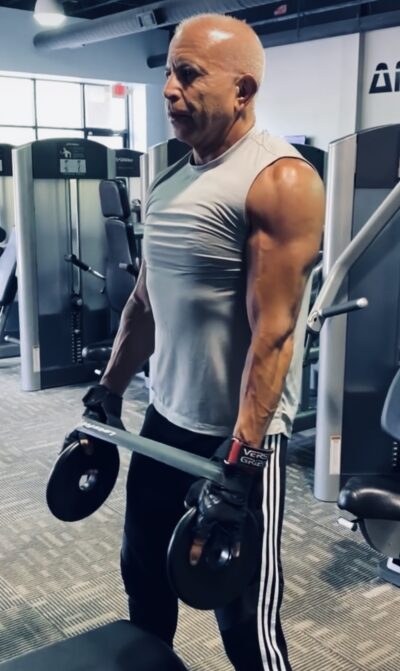BUILD MUSCLE

THE SCIENCE OF BUILDING MUSCLE
Georgia Personal Training will help you build muscle at a faster and more pronounced rate than you have ever experienced. Building muscle is a science. There are certain principals that must be followed for a client to experience optimal muscle growth. These include progressive overload, mechanical stress, muscle confusion, and executing your lifts with proper technique. GPT trainers emphasize each of these elements during every single training session. Our clients can be confident they are getting the best training in Roswell, and in turn, will see the best results. They will also be taught the science of hypertrophy, and through months of practice and repetition, clients will become proficient lifters capable of keeping themselves fit for life.
WHAT IS HYPERTROPHY
Hypertrophy is a term commonly used in the field of biology and medicine, specifically in the context of muscle growth. It refers to the increase in size or volume of cells or tissues in an organ or muscle. When we talk about hypertrophy in relation to muscle, it generally refers to the enlargement or growth of muscle fibers.
In the context of muscle hypertrophy, it occurs as a response to specific stimuli, such as resistance training and weightlifting. When we engage in exercises that challenge our muscles, microscopic damage occurs within the muscle fibers. The body then initiates a repair process, where the damaged muscle fibers are rebuilt and strengthened. This repair process involves an increased production of proteins, resulting in the growth of the muscle fibers and overall muscle size.
In summary, hypertrophy is the scientific term for muscle growth and enlargement. When someone uses the phrase hypertrophic training, they are referring to a weight lifting program focused specifically on building muscle size, more so than strength or function. Not that these don’t sometimes overlap, but not always.
Think of a professional body builder in contrast to an Olympic weight lifter. The body builder carries much more muscle mass and definition than the competitive lifter, yet he is nowhere near as strong in most cases. This is due to the differences in their training programs. One focuses on creating maximum strength, while the other focuses on creating maximum size.
BUILD MUSCLE THE GPT WAY

PROGRESSIVE OVERLOAD
The Progressive Overload Principle states that in order for muscle to grow, strength to be gained, performance to increase, or for any similar physical improvement to occur, the human body must be forced to adapt to a stress or tension that is above and beyond what it has previously experienced. The way we explain this to our athletes is “muscle will only grow if you force it to grow, the body will only get stronger if you force it to get stronger”. You have to expose the body to a level of training intensity and stress that it has never experienced, and the body will be forced to adapt to this stress over time. As the body adapts, or gets stronger and stronger, the training intensity must continuously be increased to keep this adaptation process occurring.
The majority of people aren’t aware of, or don’t understand this principle. Which is why you see so many people that have been strength training for years but show little to no visible improvements in either strength or physique. It’s human nature to gravitate to what’s comfortable. Everyone wants a basic routine, with a simple set and rep structure that’s easy to follow and replicate over and over (3 sets of 10, 5 sets of 8, etc). Everyone wants to stick to lighter weights they can comfortably handle so they don’t get “too bulky”. Its an incorrect approach caused by a total lack of understanding of the human body and how it responds to physical training.
ECCENTRIC TRAINING
ECCENTRICS TO BUILD MUSCLE
Eccentric training refers to the phase of an exercise where the muscle lengthens under tension. It is often considered the “negative” or lowering phase of the movement. During this phase, your muscles are actively resisting the force of gravity or an external resistance, such as weights. By emphasizing the eccentric phase, we can maximize muscle development and strength gains.
In our muscle and strength building training programs, we heavily utilize eccentrics to challenge your body in a unique way. When you perform an eccentric contraction, the muscle fibers are subjected to greater tension and stress compared to the concentric (lifting) phase.
This increased tension stimulates mechanical tension, the primary driver of muscle adaptation. Eccentrics also create more micro-tears and muscle damage than traditional lifting sets. Greater muscle breakdown means greater muscle growth during the recovery phase.
WORK TO FAILURE
At GPT, we strive to work our clients muscles as close to total failure as possible during strength and muscle building focused sessions. Working a muscle group to total failure means pushing it to the point where you cannot perform another repetition with proper form.
By training to failure, we effectively exhaust the muscle, depleting its glycogen stores and fatiguing the muscle fibers. This depletion signals your body to adapt by increasing muscle protein synthesis, promoting hypertrophy, and enhancing overall strength.
But more importantly, this high level of stress placed on the muscles forces the adaptation response we are looking for. The body will only grow if we force it to grow. This applies to both size and strength. Pushing to your absolute limits and beyond is the only way to see maximum size and strength gains.
It is important to note however, that working to failure doesn’t mean sacrificing proper form or risking injury. You have to know when to pull back and when to keep pushing. This is where the GPT training staff come in.
Our years of experience have taught us how to closely observe changes in your bio-mechanics and signs of fatigue as we progress through a training session. When fatigue reaches a level where clients are getting minimal efficacy or risking injury on a specific movement, we immediately pull the plug and move on to the next series.
MUSCLE DAMAGE

GPT OWNER MATT LEIN
When you engage in resistance training exercises, such as weightlifting, you create microscopic damage to your muscle fibers. As the body repairs these damaged fibers, they become stronger and thicker over time, ultimately leading to muscle growth and strength improvement. Here’s the exact hypertrophy breakdown.
1. Muscle Fiber Breakdown: Intense exercise causes tiny tears or microtrauma in the muscle fibers. These tears are a natural, and nothing to be concerned by.
2. Inflammatory Response: Following muscle damage, our bodies initiate an inflammatory response. This explains the soreness we fail after a hard lifting session. This response helps remove damaged tissue and initiates the repair process.
3. Satellite Cells Activation: Specialized cells called satellite cells, which are located around our muscle fibers, become activated in response to the damage. These cells play a crucial role in muscle repair and growth.
4. Protein Synthesis: Once activated, the satellite cells fuse with the damaged muscle fibers, donating their nuclei. This process increases the protein synthesis within the muscle fibers, contributing to muscle growth and repair.
5. Hypertrophy: Over time, with repeated bouts of exercise, the muscle fibers adapt by increasing in size and number of contractile proteins. This process is known as muscle hypertrophy, resulting in stronger and larger muscles.
MECHANICAL TENSION

60 YEAR OLD BOB GONSALVEZ
While muscle damage refers to the microscopic breakdown of muscle fibers during exercise, mechanical tension refers to the force or stress placed on the muscles during contraction. Mechanical tension plays a massive role in muscle growth by triggering a series of physiological responses that literally force your muscles to adapt and grow.
Mechanical tension is a crucial stimulus for muscle growth, and it occurs when we subject our muscles to resistance or load during exercise. This tension activates the muscle fibers, leading to muscle contraction and subsequent adaptations in muscle strength and size.
While both muscle damage and mechanical tension contribute to muscle growth, they are distinct mechanisms. Muscle damage initiates the repair and growth processes, while mechanical tension provides the stimulus for muscle fibers to adapt and get stronger.
METABOLIC STRESS

STRONG IS BEAUTIFUL
Metabolic stress refers to the physiological changes that occur within our muscles during intense weight training. When we lift weights, we expose our muscles to tension and stress. This stress triggers a series of adaptive responses within our body to cope with the demands of the exercise.
Metabolic stress is primarily caused by the accumulation of metabolic byproducts, such as lactate, hydrogen ions (H+), and other metabolites, in the working muscles. This occurs due to the increased energy demands during weight lifting exercises. The accumulation of these byproducts creates an acidic environment within the muscle, leading to a variety of physiological responses.
This acidic environment triggers the release of anabolic hormones, such as growth hormone and insulin-like growth factor-1 (IGF-1). These hormones play a crucial role in muscle growth by promoting protein synthesis and muscle repair. They also help to increase the production of satellite cells, which are responsible for muscle regeneration and hypertrophy (muscle growth).
Additionally, the accumulation of metabolic byproducts also leads to the expansion of blood vessels in the muscles, known as vasodilation. This enhanced blood flow brings more nutrients, oxygen, and hormones to the muscles, aiding in their repair and growth. Furthermore, metabolic stress activates a group of proteins that sense the mechanical tension placed on the muscle.
These proteins then signal the body to adapt by increasing protein synthesis and muscle fiber recruitment. GPT trainers maximize metabolic stress by utilizing high-rep sets, drop sets, supersets, time under tension exercises, and tempo training. In doing so, maximize our client’s ability to build muscle effectively.
WHY MOST PEOPLE FAIL TO BUILD MUSCLE
There are three specific reasons why people struggle to build muscle from their workouts.
1. Improper Technique: Using proper form during training is crucial for muscle growth. It ensures that you’re targeting the intended muscles optimally and minimizing the risk of injury. Many people overlook this aspect, or don’t take the time to learn to execute their lifts properly. If you’re unsure about the correct technique for a specific exercise, contact the GPT training team, and get on the books for a free consultation.
2. Lack of Progressive Overload: Without progressive overload, your muscles won’t be challenged enough to adapt and grow stronger. It’s important to find the right balance and gradually push yourself to the next level to stimulate muscle growth effectively. Most gym goers don’t understand this fact. They establish a basic routine and rinse and repeat for years with absolutely zero progress being made.
3. Insufficient Volume: Volume refers to the total amount of work performed in a training session, primarily the number of sets and repetitions. Very few individuals actually do enough volume to build muscle from their workouts. While it’s good to avoid overtraining, ensuring an adequate volume during your workouts is crucial. This means finding the right balance between challenging your muscles and allowing them enough time to recover.
Even if personal training is not for you, we would love to have you as a member of our beautiful 24 hour gym. The Roswell Fitness Factory is open 24 hours to it’s members. Members have access to all of the same equipment and accessories that GPT clients do. Fitness coaching options are also available.

